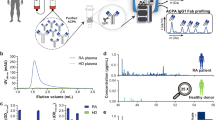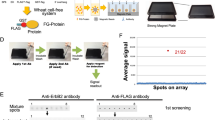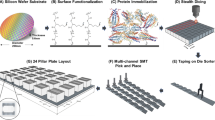Abstract
We have previously reported the development and the use of a 'reverse capture' autoantibody microarray for studies of antigen-autoantibody profiling. We developed the 'reverse capture' autoantibody microarray to allow the user to characterize and to compare autoantibody profiles. Based on the dual-antibody sandwich immunoassay of ELISA, our 'reverse capture' protocol facilitates the detection of autoimmunity to native host antigens. Our method has the advantage over traditional protein arrays of being able to detect autoimmunity to epitopes found on the post-translational modifications (PTMs) of native antigens. The first step of this method is to immobilize native antigens onto the monoclonal antibodies spotted on the array surface. Using the antigens captured by the microarray as 'baits,' we then incubate the array with differentially labeled IgG from test and control samples, and perform a two-slide dye-swap to normalize for dye effects. In this protocol we present a detailed description of the 'reverse capture' autoantibody microarray, a method that can be completed in 9–10 h over 1–2 d.
This is a preview of subscription content, access via your institution
Access options
Subscribe to this journal
Receive 12 print issues and online access
$259.00 per year
only $21.58 per issue
Buy this article
- Purchase on Springer Link
- Instant access to full article PDF
Prices may be subject to local taxes which are calculated during checkout





Similar content being viewed by others
References
Mintz, P.J. et al. Fingerprinting the circulating repertoire of antibodies from cancer patients. Nat. Biotechnol. 21, 57–63 (2003).
Wang, X. et al. Autoantibody signatures in prostate cancer. N. Engl. J. Med. 353, 1224–1235 (2005).
Hueber, W. Antigen microarray profiling in rheumatoid arthritis. Arthritis Rheum. 52, 2645–2655 (2005).
Robinson, W.H., Steinman, L. & Utz, P.J. Protein and peptide array analysis of autoimmune disease. Biotechniques 33, S66–S69 (2002).
Qin, S., et al. Development of a 'reverse capture' autoantibody microarray for studies of antigen-autoantibody profiling. Proteomics 6, 3199–3209 (2006).
Liu, B.C. & Ehrlich, J.R. Proteomics approaches to urologic diseases. Expert Rev. Proteomics 3, 283–296 (2006).
Anderson, K.S. & LaBaer, J. The sentinel within: exploiting the immune system for cancer biomarkers. J. Proteome Res. 4, 1123–1133 (2005).
Dunn, G.P., Old, L.J. & Shreiber, R.D. The immunobiology of cancer immunosurveillance and immunoediting. Immunity 21, 137–148 (2004).
Madrid, F.F. Autoantibodies in breast cancer sera: candidate biomarkers and reporters of tumorigenesis. Cancer Lett. 230, 187–198 (2005).
Jacobson, D.L., Gange, S.J., Rose, N.R. & Graham, N.M. Epidemiology and estimated population burden of selected autoimmune diseases in the United States. Clin. Immunol. Immunopathol. 84, 223–243 (1997).
Vossenaar, E.R. et al. Rheumatoid arthritis specific anti-Sa antibodies target citrullinated vimentin. Arthritis Res. Ther. 6, 86–89 (2004).
Casciola-Rosen, L., Andrade, F., Ulanet, D., Wong, W.B. & Rosen, A. Cleavage by granzyme B is strongly predictive of autoantigen status: implications for initiation of autoimmunity. J. Exp. Med. 190, 815–823 (1999).
Acknowledgements
This work was supported in part by grants U01DK063665 and R01DK066020 from the US National Institutes of Health to B.C.-S.L.
Author information
Authors and Affiliations
Corresponding author
Ethics declarations
Competing interests
A patent is currently pending for our 'reverse capture' autoantibody microarray platform and protocols.
Rights and permissions
About this article
Cite this article
Ehrlich, J., Qin, S. & Liu, BS. The 'reverse capture' autoantibody microarray:a native antigen-based platform for autoantibody profiling. Nat Protoc 1, 452–460 (2006). https://doi.org/10.1038/nprot.2006.66
Published:
Issue Date:
DOI: https://doi.org/10.1038/nprot.2006.66
This article is cited by
-
Autoantibody biomarkers identified by proteomics methods distinguish ovarian cancer from non-ovarian cancer with various CA-125 levels
Journal of Cancer Research and Clinical Oncology (2013)
-
Anti-CDC25B autoantibody predicts poor prognosis in patients with advanced esophageal squamous cell carcinoma
Journal of Translational Medicine (2010)
Comments
By submitting a comment you agree to abide by our Terms and Community Guidelines. If you find something abusive or that does not comply with our terms or guidelines please flag it as inappropriate.



